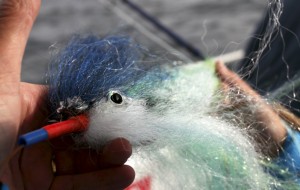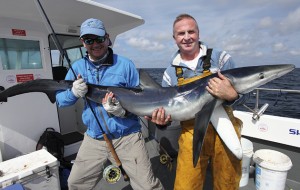There’s no need to head off to exotic climes for the fight of your life. A sharking trip to Milford Haven gets the adrenalin pumping for Tobias Coe
It seems that, every year, the boundaries of fly-fishing are being pushed back around the world. It may sound slightly daft to compare fly-fishing with, say, off-piste skiing, but it is no mean feat using a stick of carbon no thicker than your little finger to catch monstrous tarpon from float tubes, huge dorado from tiny jungle streams or black marlin on the flats of Australia.
On home turf, one might be forgiven for thinking that there is no place for such antics. We all know about bass and pollack on the fly. Pike, those “killers from the egg”, are in most fly-fisher’s consciousness and their capture is not really an occasion for fist-bumps, whoops and adrenalin-pumping music. Similarly, the capture of trout and salmon is generally a laconic and calm affair.
My ears therefore pricked up markedly when, while fishing in Cuba early last summer, I heard mention of sharks on the fly in UK waters. The chaps concerned, Allan Shephard and Duncan Goldsmith, weren’t talking about dogfish, either. According to Goldsmith, these fish would “bend a #14 to the butt, strip serious amounts of line from a tightly set drag and bite through 150lb wire as if it were cotton”. Bullets have left rifles more slowly than the “Yes” that departed my lips when asked whether I would like to join them for a day.
Most anglers will be aware of the blue sharks that arrive at our shores in the summer months. Migrating from warmer climes in southern Europe and, in some cases, from across the Atlantic, in the past their stronghold was around the shores of the south-west. However, in recent years an exciting fishery for them has been discovered off the south-west tip of Wales, pioneered by skipper Andrew Alsop.
Shark populations around the world have declined massively over the past few decades, but the results being seen in Wales are exceptional for UK waters and would suggest that all is not yet lost. Not only are there large numbers of sharks in the area (days of 20-plus landed fish are not uncommon), but many of them are big. Small blues in the 30lb to 50lb class tend to be much less common than those ranging from 50lb to 100lb. This abundance spurred Shephard and Goldsmith into convincing Alsop to let them have a crack with the long rod, as did their why-the-heck-not attitude.
On the July morning I joined them, we left Milford Haven just before the first glimmer of light appeared in the sky, a thick mist hanging over us. Motoring out of the harbour, we opened up the throttle and headed into the Welsh dawn. Arriving at our chosen location for the day (which appeared to be a an area of sea indistinguishable from any other patch of sea), Alsop killed the motors and, with deckhand for the day Byron Way, went about preparing perhaps the most crucial ingredient for a successful outing for sharks.
Handfuls of mackerel and herring, bran, fish oil and even halibut pellets went into a large plastic bucket, where a vigorous pounding with a steel bar turned them into mush. This was distributed into mesh sacks, slung overboard on a rope. With the “rubby-dubby” (or chum) sending an oily slick in our wake and rods strung up and flies tied on, Alsop explained to me what to look for.
“Generally, the first sign that a shark is in the area comes from the birds. Currently, they’re sitting happily on the water, picking up some of the bits of chum. However, if they detect a shark they will get agitated, looking around and often taking off from the water surface. If you think you saw a bird in a spot, look back a moment later and the bird has been replaced by a big swirl on the surface, chances are that one wasn’t paying enough attention and has ended up as a snack.”
On to fishing tactics. I will come clean at this point and say that the method we used was not classical fly-fishing. A big fly was attached to the end of a long, wire trace and a chunk of herring or mackerel impaled on the hook and thrown overboard. Most of the fly-line was then paid out over the side and the whole lot left to drift behind the boat, with the odd tweak and pull used to impart some action. This technique is really, at best, fly-rodding. However, given what we experienced over the course of the next few hours, most would probably not turn their noses up at it.
Flies in the water, we all watched the fulmars and gulls paddling around the boat, willing a shark to make an appearance. Suddenly, as if someone had flicked a trigger,
it happened. The birds started skittering around and suddenly took to the air en masse. Almost at the same moment, a cry went up from Shephard. A hard strip-strike and his rod went into a parabolic curve as something big and angry starting stripping line from his reel at a rate of knots.
Ten minutes later I felt a bump through my line, followed by a weight on the other end. A solid strip and something large took off to-wards the middle of the Atlantic, with a run that stripped a good chunk of backing from the reel. After stopping the fish at the end of this run, the remainder of the fight was dogged, the fish using its weight to make short, powerful runs until, finally, a stunning blue shark of about 70lb loomed up through the water.
When seen in the flesh, it is instantly obvious why the species got its common name. They are spectacular-looking fish: deep azure over the back and top half of the body is accentuated by the brilliant white of the belly. The long, pointed nose looks almost comical, particularly if one is held aloft for a picture. In such a pose, the long “snout”, slightly down-turned mouth and long pectorals give the impression of a sad-looking dog.
The rest of the day saw a pretty-much continual stream of sharks come to the boat, save for a quiet couple of hours around lunch-time. At times the fishing was manic: there were periods in which three anglers were hooked up to sharks simultaneously. While some fish came to the boat relatively easily, others gave us a real run for our money.
Shephard hooked one fish in particular that tore off with such speed and strength that we thought it might be a highly sought por-beagle shark. The fish ran straight down after the initial hook up and then doggedly refused to come up to the surface, announcing its displeasure with several sizzling runs back down into the depths. Eventually, however, a broad blue back appeared below the boat and our exuberance was quashed; a porbeagle on a fly rod would have to wait for another time.
We ended the day with 29 sharks landed and a significant number lost or missed on the strike. They ranged in size from a couple of small fish in the 30lb to 40lb bracket up to a behemoth of 116lb that Goldsmith landed. These are phenomenal catch figures, even more so when you consider that every fish was caught on a fly rod.
Most excitingly, some of the fish were really fired up and unquestionably on the hunt. One of these super-charged sharks came into the chum trail high in the water, with that stomach-turning sight of a fin slicing through the surface. In readiness for such an event and as a result of observing shark and seagull interactions, Shephard had prepared a special Seagull fly. A large chunk of polystyrene the shape of half a rugby ball and festooned with feathers, it is, perhaps, the strangest “fly” I have ever seen. The shark didn’t seem to care and, with much tail thrashing, took the whole concoction from the surface.
A couple of others came right in around the boat in an extremely aggressive manner, fins flared, in search of our flies. I’m convinced that had we cast normal, unbaited flies properly to these fish, with the flies presented in the correct place, they would have eaten them. At the moment, however, the guys who took me out just want to hook into fish. Given that there are precious few days in a year when they get to do this and that they are pioneering this fishing in the UK, I can hardly blame them.
For the purists, the exciting thing is that the indications are there that these fish can be caught using typical saltwater fly-fishing techniques. It is unlikely that you will catch two dozen in a day in this manner, but there is a genuine potential here to catch a 100lb fish on a cast fly in UK waters. We have only just started to scratch the surface and I can’t wait to see how the fishery develops.








